Lenovo Yoga Book 9i OLED Review: Dual OLED displays are more a revolution than a gimmick
A supremely versatile two-screen ultraportable, but Leonovo must deliver more optimised software
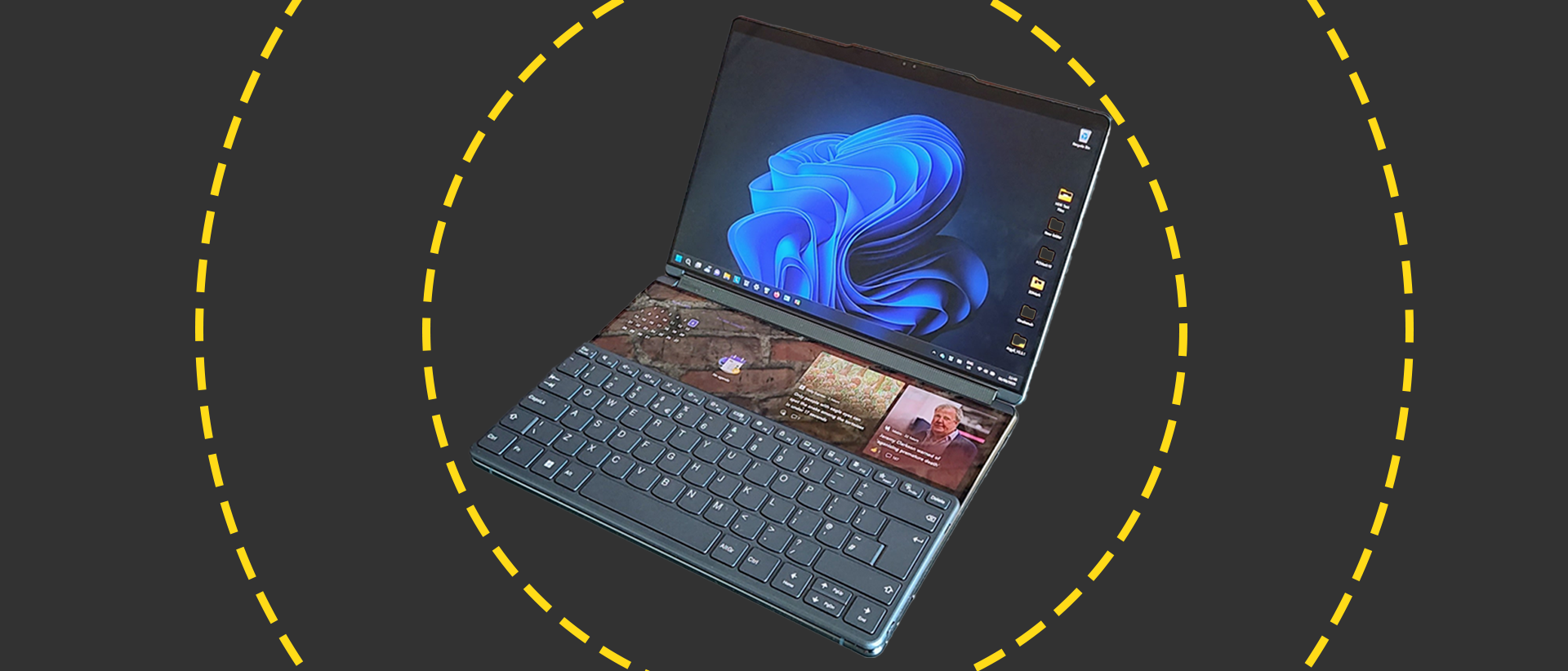
-
+
Very versatile
-
+
Two 2.8K 13.3-inch OLED screens
-
+
Decent battery life
-
+
Excellent speaker system
-
-
No memory card slot or 3.5mm audio jack
-
-
Software package unfinished at the time of writing
-
-
Integrated GPU limits graphics capability
-
-
The odd system glitch

The idea of taking a laptop and replacing the keyboard deck with a second display is not new. Acer tried it with the Iconia 6210, which was built around two 14-inch, 1,366 x 768 touchscreen displays back in 2010. I dimly recall fiddling about with one and thinking it was an answer to a question nobody had ever, or would ever, ask.
Modern display technology is giving the basic idea behind the Iconia 6210 a new lease of life with machines like the Asus Zenbook Fold OLED, and the new Lenovo Yoga Book determined to make physical keyboards a think of the past. Well, almost. Leonovo bundles the Yoga Book with a physical Bluetooth keyboard, so there's life in that old dog.

When faced with a product like the Yoga Book, something that could just as easily be described as daft as revolutionary, it helps to be able to distil what it offers into a concise and simple sentence, so here goes: The Yoga Book is a Windows laptop with two displays. If you do not need two displays, there's no need to pay £2,000 for the Yoga Book when you can buy something like the Asus Zenbook 14 Flip for half the price.
But the Yoga Book could answer your prayers if you need a mobile two-screen solution without all the palaver of a separate portable display, most of which are rather drab and dreary IPS affairs.
Lenovo Yoga Book 9i: Design
While the Zenbook Fold uses a one-piece flexible display, the Yoga Book consists of two screens with a hinge between them. That puts a 20mm gap between the two displays, but Leonovo has used the space well by turning it into a soundbar.
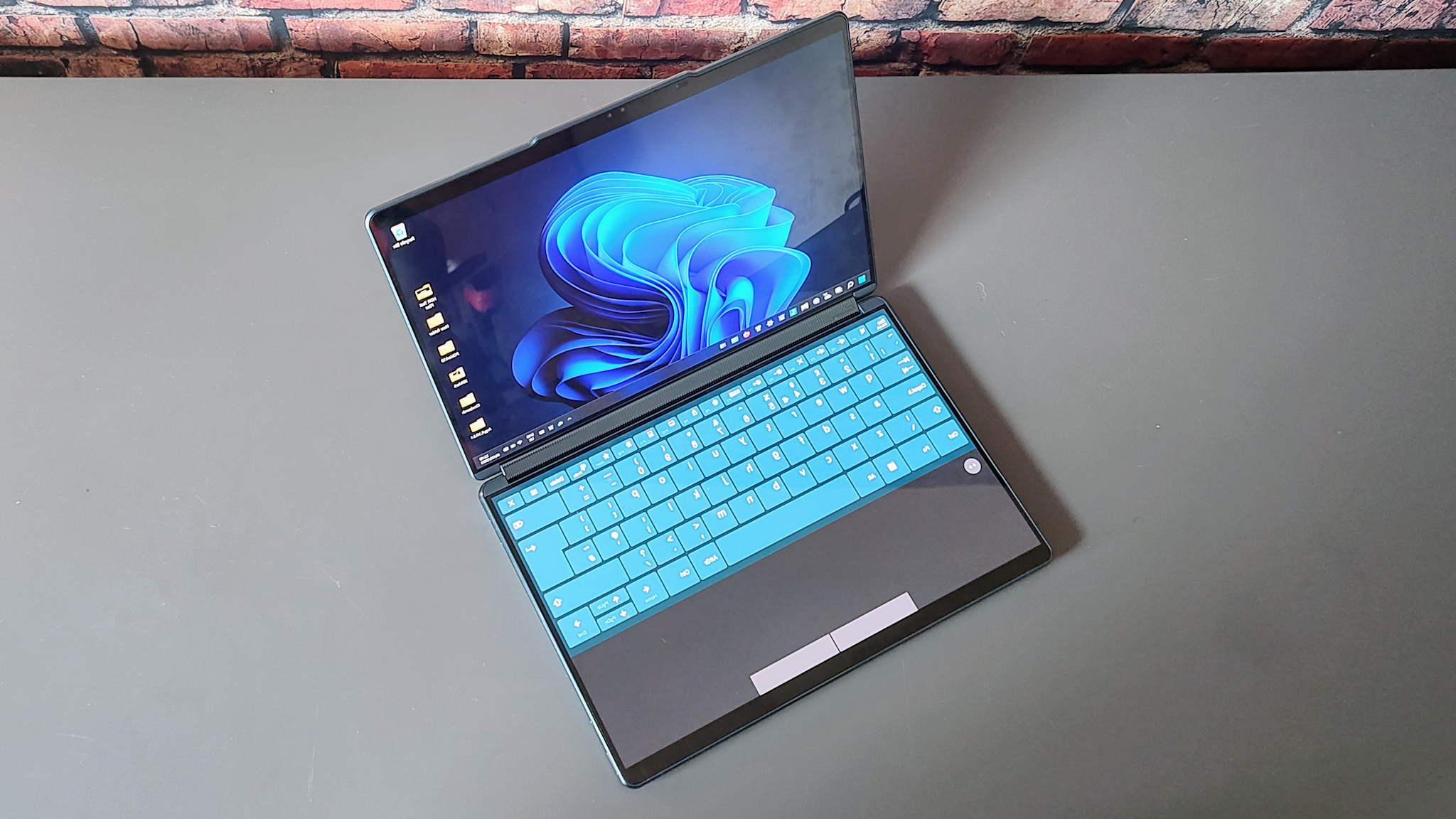
An all-metal clamshell design with rounded sides, the Yoga Book is an impressively smooth and solid affair with no wobble in the displays or around the 360-degree hinge. At 299.1 x 203.9 x 15.95mm and 1.2Kg it's small and light enough to slip into a backpack and sit unnoticed. If you look carefully, you will see that the lower part with the ports and the power button is slimmer than the upper part, but the difference is negligible.
Sign up today and you will receive a free copy of our Future Focus 2025 report - the leading guidance on AI, cybersecurity and other IT challenges as per 700+ senior executives
The origami stand, Bluetooth keyboard and active stylus add another 400g to the proceedings. Still, they pack down into a space not much larger than the keyboard itself, and the elastic sleeve for the stylus keeps it firmly in place whether the stand is wrapped up for transit or in use as a support for the Yoga Book.
The Yoga Book is not exactly replete with ports. Three Thunderbolt ports are all you get, one on the left and two on the right. If you are charging, you will need one of the ports to connect the 65W charger that Lenovo bundles. Other than the power button and webcam kill switch on the right at the front, the sides of the Yoga Book are free of ports, slots, and jacks. There isn't even an audio jack though the increasing ubiquity of Bluetooth earphones means this is not the issue it once was.
The origami stand itself is an impressive piece of design. Once you've opened it up, you simply place the magnetic rear edges together, at which point it forms a sort of triangular funnel on which you can stand the Yoga Book in either landscape, with both screens staked in front of you almost vertically, or portrait with it open like a hardback book.
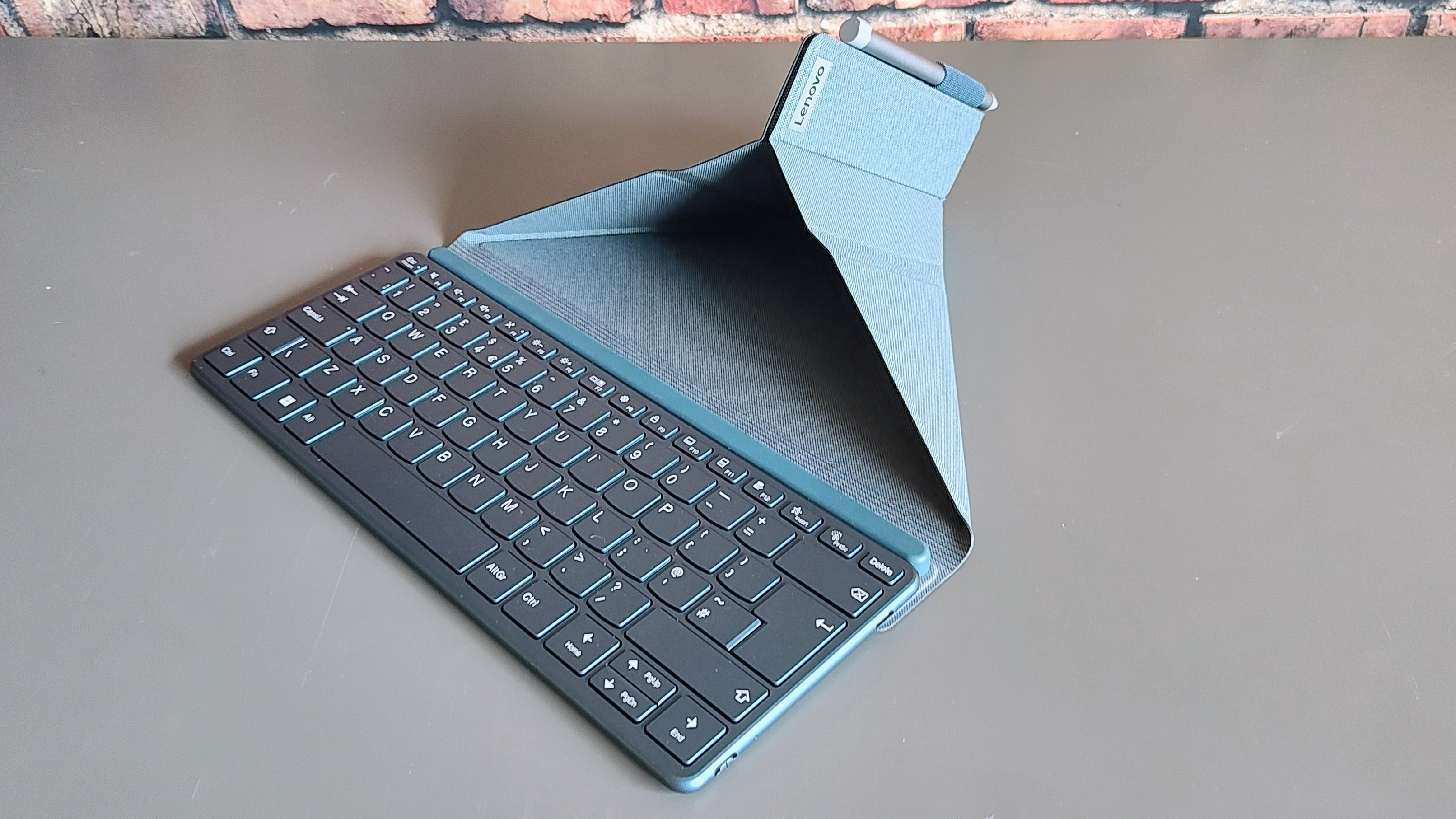
Looking at the stand empty, you fear for the stability of the design, but once the Yoga Book is in place, it's all surprisingly stable and sturdy, helped by the deep bar at the front, which prevents the Yoga Book from sliding forward.
In the absence of the stand, you can use the Yoga Book in either laptop form, in tent mode or as a tablet, albeit a relatively thick one. In "tent" form with Windows set to duplicate rather than extend the display, it is a great tool to present to someone across from you. The Yoga Book is a supremely versatile design.
We do, however, wish at least one of the Thunderbolt ports had been placed at the front of the lower part. As it is, cables and docks dangle in mid-air when the Yoga Book is set in the stand in portrait because all the ports are effectively in the middle of the device.
Lenovo Yoga Book 9i: Software
If the hardware part of the Yoga Book is a triumph, the software part is somewhat half-baked in places. To start with, while the Smart Note app is present and correct, the Smart Reader e-reader app, which lets you read PDF, Mobi, Epub and text files as books with one page on either screen, is listed as "Coming Soon".
Similarly, the widget bar that appears above the keyboard is limited to showing your Outlook calendar on the left and the Windows news feed on the right. There really should be more options on offer, even if it's only to see your Outlook inbox.
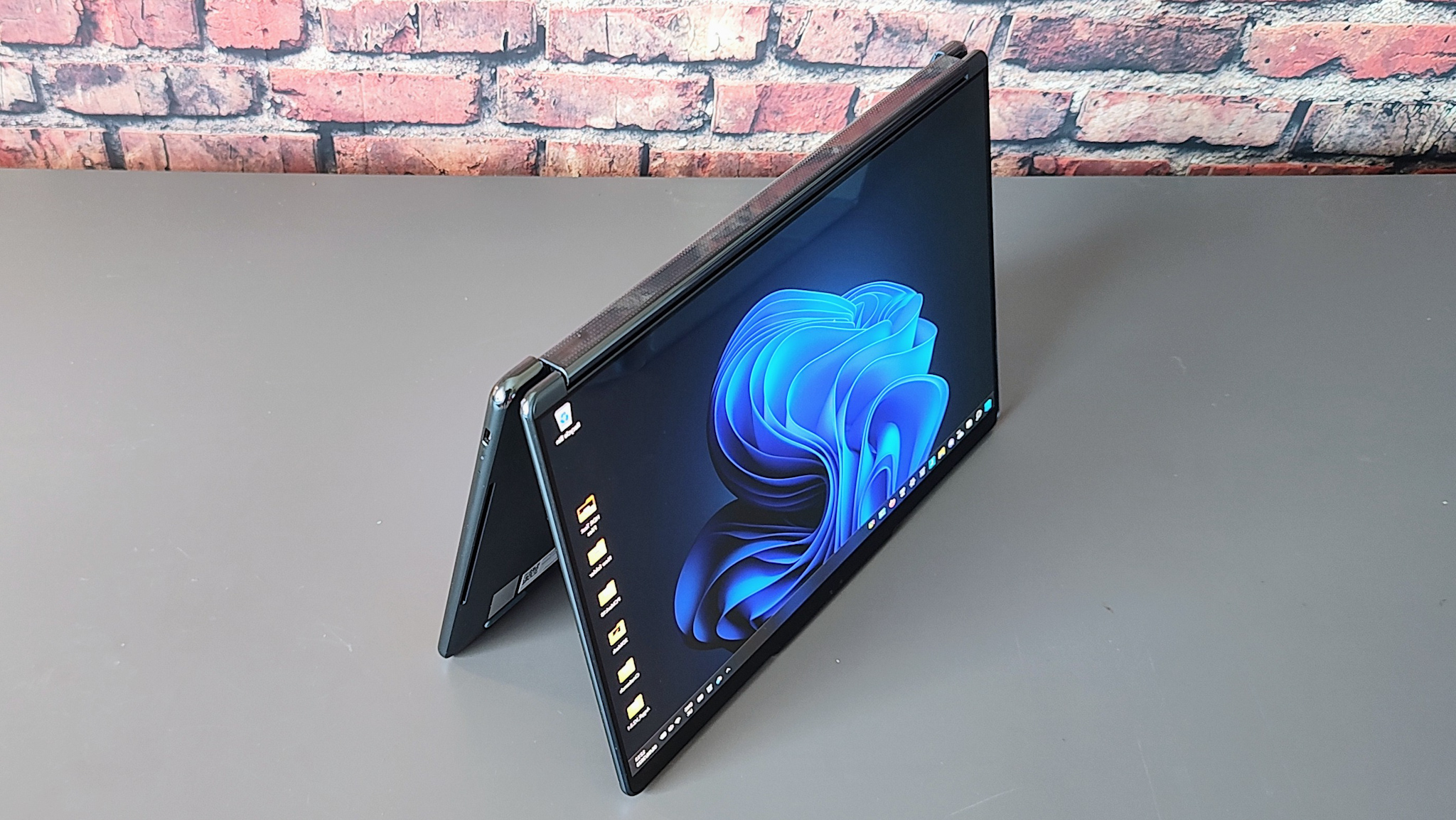
There are a few system glitches, too: Sometimes, the cursor would just vanish from the screen. This only seemed to happen in general use when we used the small trackpad, but when dialogue or alert boxes popped up on the main screen, it happened regardless of the touchpad format. A quick tap of the display with finger or pen got us out of the bind, but that's not the point.
According to the Dual-screen Settings tab in the User Center CP, you should be able to 'flick' open windows between the two screens, but the action only ever worked when flicking from the top screen to the bottom, never vice versa. You can tap the open app icon in the taskbar to achieve the same result, which is just as well, as sometimes windows would refuse point blank to let us pick them up.
None of these foibles are what we'd call deal breakers, but they do speak to a worrying lack of attention to detail by Lenovo, which isn't acceptable on a device costing this much.
Lenovo Yoga Book 9i: Keyboard, Touchpad and Webcam
The bundled Bluetooth keyboard is impressive, with a positive and clean, if rather shallow key action and a good layout. The only faults we found with it are the lack of fold-away feet to increase the angle of attack (there is a foldable, magnetic card stand in the box, which we presume is for use as a keyboard riser, but it's no real replacement for feet and is too steep for our liking) and the absence of a backlight. Given the cost of the Yoga Book, the last is hard to swallow.
The virtual keyboard can be summoned onto the lower screen by either an eight-fingered tap, touching a text entry box or tapping the keyboard icon in the system tray. It offers four levels of haptic feedback, a sound option to accompany each keystroke and a wide range of opacity ranging from solid to nearly transparent.
It is the best Windows virtual keyboard I've encountered, though admittedly, that's not a high bar. At the touch of a button (F10, to be precise), the keyboard can either occupy the top 60% of the lower screen with a touchpad and buttons below it (the touchpad can be set to occupy the same 110mm-wide space as the two virtual buttons below it or the entire width of the screen, our preferred option). Or the keyboard can drop into the lower 60% with a widget bar occupying the space above if you use a Bluetooth mouse.
If you drop the Bluetooth keyboard onto the lower screen at the top, then once again, the visual touchpad appears. Move it to the lower part, and the widget bar materialises. The physical keyboard is held in place by magnets that are strong enough to keep it in place but not so strong that you can't pick it up and remove it single-handedly.
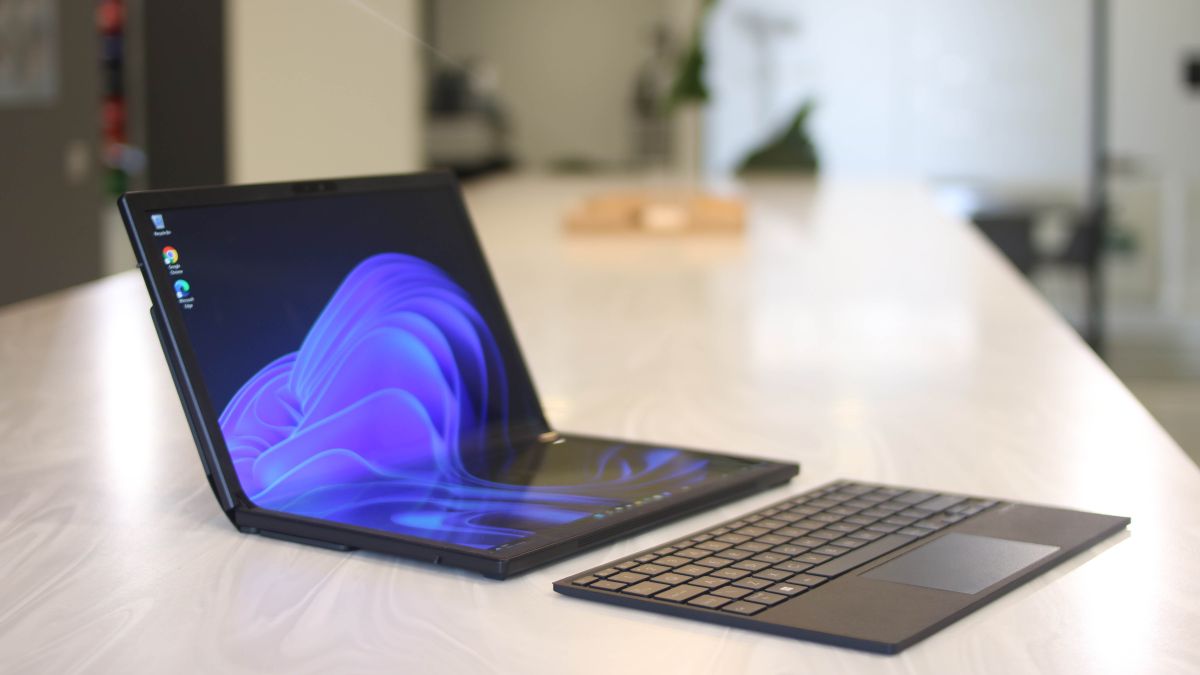
The 1080p webcam proved to be a solid performer capturing a bright and crisp video image with decent colour saturation. Once you download the Lenovo Smart Appearance App, you can access features like face tracking and virtual or blurred backgrounds and a disturbingly wide range of facial adjustments. These are similar to the features that Asus bundles with its high-end compact laptops, but unlike the Asus system, all the filters on the Yoga Book can be used simultaneously.
The camera also has an IR scanner to support Windows Hello facial recognition, which is important in the absence of a fingerprint scanner, and there is a physical camera kill switch.
There was nothing extraordinary about the performance of the SKHynx PCIe 4 SSD, but the sequential read and write speeds of 3,925MB/s and 1,944MB/s were perfectly respectable for a machine of this category.
Lenovo Yoga Book 9i: Display and Speakers
The two 2,880 x 1,800, 16:10 255dpi OLED panels proved remarkably consistent in their performance, each registering peak SDR brightness of 368cd/m2 and each showing colour gamut coverages of 100% sRGB, 97.8% Adobe RGB and 98.7% DCI-P3. In HDR mode, the maximum brightness from an area <10% jumped to 576cd/m2, easily above the maximum mandated by the Yoga Book's Vesa DisplayHDR 500 TrueBlack certification.
That peak SDR brightness is acceptable for indoor use, and thanks to the infinite contrast ratio typical of OLED screens, content looks superb, but in bright outdoor environments, reflections from the gloss-finish glass screens are an issue.
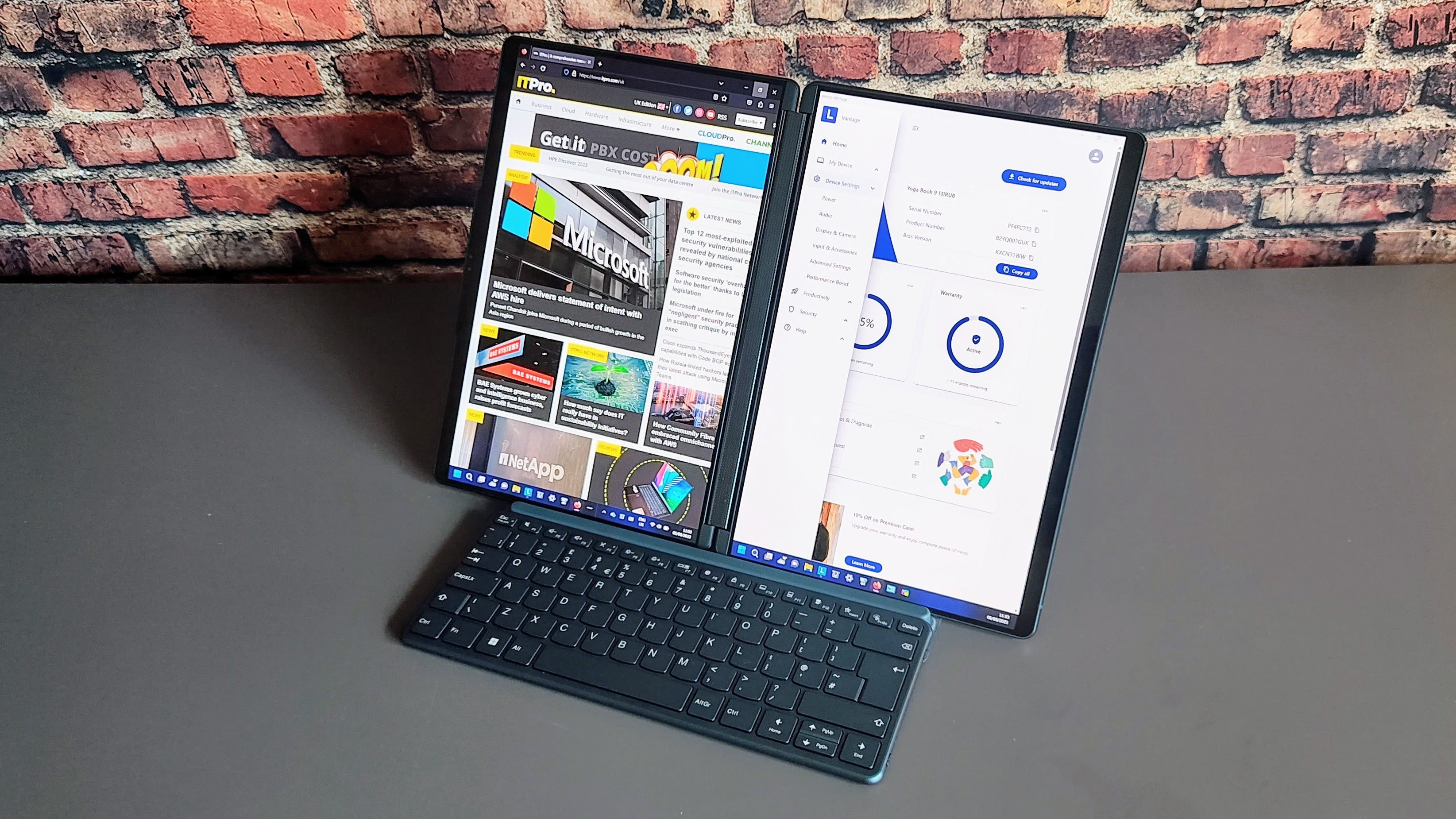
Lenovo doesn't bundle any software to change between color profiles, and the Leonovo Display Control Centre on the Microsoft Store wouldn't talk to either monitor, so you are stuck with the basic Windows color profile.
The display is – or rather the displays are – very colorful thanks to expansive gamut volumes of 167% sRGB, 116.2% Adobe RGB, and 119.4% DCI-P3. Color accuracy was excellent, with the average Delta E 94 coming in at 0.3.
Usefully you can adjust the brightness levels of each screen independently, meaning you can lower the level on the keyboard screen while keeping the main display nice and bright. The same is true for HDR; you can engage it on either display, on both, or on neither. In this respect, the Yoga Book behaves just like a Windows laptop with a portable monitor attached to it.
The soundbar that joins the two halves of the Yoga Book is home to 2 x 2W and 2 x 1W speakers made by Bowers & Wilkins. They do an excellent job of work, pumping out an impressively loud 80dB(A) as measured from a pink noise source at a 1m distance. The soundscape is underpinned by amble bass, and the higher ranges have plenty of expansive detail.
Bundled with the Yoga Book in the UK is Lenovo's new Active Pen 3. With 4,096 levels of pressure and tilt detection, it worked well with Adobe Fresco as well as Lenovo's own Smart Note app and proved a handy tool for sketching, note-taking, and photo editing.
Lenovo Yoga Book 9i: Specs and Performance
The Yoga Book runs on an Intel Core i7-1355U CPU, a 10-core component with a maximum TDP of 28W, and just two performance cores. Graphics are handled by Intel's Iris XE integrated GPU, and you get 16GB of LPDDR5X RAM. As you would expect from what is essentially two tablets joined together, there's no way to take anything apart, so user upgrades are out of the question.
The Yoga Book scored 163 in our standard 4K media benchmark and 5,506 in the PCMark 10 test. Both are good results for a machine built around a U-series Raptor Lake CPU and indicative of a level of performance that will take most office productivity jobs in its stride.
The issue for us is that the form factor of the Yoga Book primarily lends itself to video editing with programs like Adobe Premiere Pro or DaVinci Resolve, which support dual monitor use, and here, unsurprisingly, the Yoga Book struggles: Rendering a 5min 4K video clip in DaVinici took 4:45 on the Yoga Book compared to 1:49 on the Asus ZenBook Pro 14 with it's RTX 4070 GPU and Core i9-13900H CPU.

The Yoga Book is clearly no gaming machine, but Lenovo has made a bit of an effort on this front, so if you download Modern Combat 5, Dungeon Hunter 5 or Asphalt 9 from the Microsoft Store, you can view the map in those games on the lower screen.
Heat management is good, especially when remembering that the Yoga Book is passively cooled. At no point in testing did thermal throttling rear its ugly head, and the warmest the bottom part of the assembly got was 40°C during stress testing.
Battery life was surprisingly good for a machine with two displays, Looping a video in VLC with the main display set to 170cd/m2 and the second display set at 50cd/m2 so the keyboard was just visible, drained the 80Wh battery in 8:33, which was a far sight longer than we expected. Turn one screen off altogether and you can get 10 hours of light use from a full charge.
Lenovo Yoga Book 9i: Price
There's only one model of the Yoga Book 9i available in the UK, and it will set you back £2,299 with VAT or £1,915 without. That's quite steep when you can pick up the likes of the Asus Zenbook Flip 14 for around £1,250 ex VAT, filling much the same space but with one touch screen and a proper keyboard. A 13.3-inch MacBook Pro will set you back a similar amount.
The deciding factor will be the dual-screen format; right now, it's a good reason to buy the Yoga Book, but if Lenovo devoted some more attention to bespoke software, it could become an irresistible reason: The missing Smart Reader app really did irk us. Here's hoping Lenovo puts the pedal down with software development for the Yoga Book. It deserves it.
Lenovo Yoga Book 9i review: Specifications
| Display | 2 x 13.3-inch 2,880 x 1,880 OLED touchscreen 16:10 aspect ratio, 60Hz refresh rate, 368cd/m2 DSR, 576cd/m2 HDR peak brightness |
| Processor | Intel Core i7-1355U 10-core, 5GHz |
| GPU | Intel Iris Xe integrated graphics |
| RAM | 16GB LPDDR5 |
| Ports | Thunderbolt 4 x 3 |
| 3.5mm audio jack | No |
| Camera | FHD camera with IR function to support Windows Hello |
| Storage | 1TB M.2 NVMe PCIe 4.0 SSD |
| Wi-Fi | 6 GHz Wi-Fi 6E (802.11ax) |
| Bluetooth | v5.2 |
| Weight | 1.2Kg (1.6Kg with keyboard, pen & stand) |
| Size | 299.1 x 203.9 x 15.95mm |
| Battery Capacity | 80Wh |
| Operating System | Windows 11 Home |
Over the years, Alun has written freelance for several online publications on subjects ranging from mobile phones to digital audio equipment and PCs and from electric cars to industrial heritage. Before becoming a technology writer, he worked at Sony Music for 15 years. Quite what either occupation has to do with the degree in Early Medieval History he read at the University of Leeds is a bit of a grey area. A native of Scotland but an adopted Mancunian, Alun divides his time between writing, listening to live music, dreaming of the glens and dealing with an unhinged Norwegian Elkhound. For ITPro, Alun reviews laptops and PCs from brands such as Acer, Asus, Lenovo, Dell and HP.
-
 Trump's AI executive order could leave US in a 'regulatory vacuum'
Trump's AI executive order could leave US in a 'regulatory vacuum'News Citing a "patchwork of 50 different regulatory regimes" and "ideological bias", President Trump wants rules to be set at a federal level
By Emma Woollacott Published
-
 Microsoft Excel is still alive and kicking at 40 – and it's surging in popularity as 82% of finance professionals report ‘emotional attachment’ to the spreadsheet software
Microsoft Excel is still alive and kicking at 40 – and it's surging in popularity as 82% of finance professionals report ‘emotional attachment’ to the spreadsheet softwareNews A recent survey found Gen Z and Millennial finance professionals have a strong “emotional attachment” to Microsoft Excel
By Emma Woollacott Published
-
 LastPass hit with ICO fine after 2022 data breach exposed 1.6 million users – here’s how the incident unfolded
LastPass hit with ICO fine after 2022 data breach exposed 1.6 million users – here’s how the incident unfoldedNews The impact of the LastPass breach was felt by customers as late as December 2024
By Emma Woollacott Published
